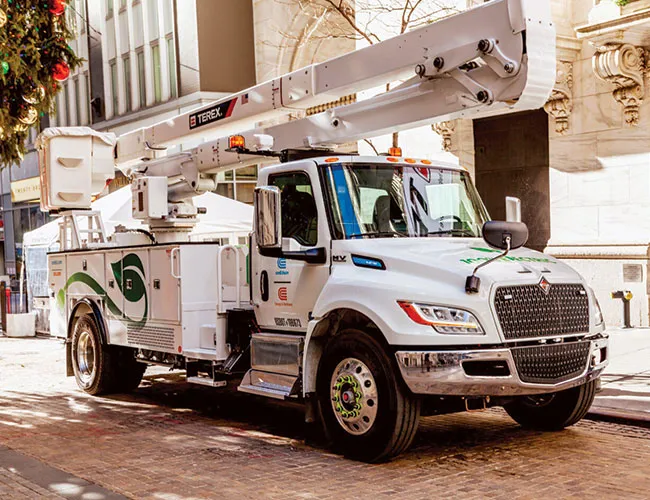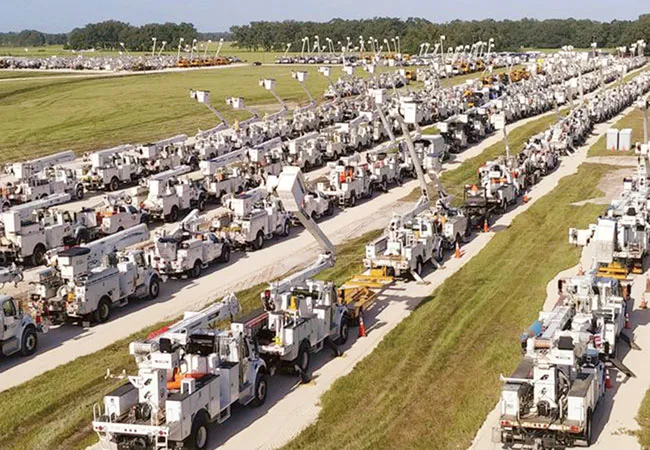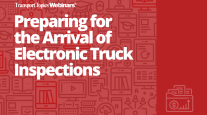Special to Transport Topics
Demand for Electric Power Takeoff Systems Is Growing

An electric power takeoff unit can allow a truck operator to run powered equipment, such as bucket lifts and cranes, without using the idling engine as a power source. (Viatec)
[Stay on top of transportation news: Get TTNews in your inbox.]
The ubiquitous power takeoff unit, a staple of thousands of vocational work trucks across dozens of industries, is on the verge of a makeover, as more operators are finding benefits in electric systems.
Traditionally, a PTO unit runs off a work truck’s internal combustion engine and transmission, integrated with the powertrain and using an idling engine to operate. Typical applications are powering auxiliary equipment on the work truck, such as bucket lifts, cranes, hoists or winches, as well as water pumps on tankers, mixing cement or walking floor trailers, or liftgates. All depend on the energy generated by the diesel or gasoline motor to run the PTO.
Industries, businesses and municipalities, recognizing the present-day challenges of climate change as well as the rising costs of operating and maintaining fossil-fueled equipment, are looking for fresh solutions. And just as electrification is gaining traction with vehicles, so too is demand for fully electric PTO systems.
These next-generation models come with sophisticated technology built on higher-capacity batteries, deliver longer duty cycles and lower operating costs, and can power far more than just a bucket lift or a winch.
Meghann Erhart of Relay Payments shares ways to prevent falling prey to fuel card skimming. Tune in above or by going to RoadSigns.ttnews.com.
The systems available today are “plug and play” and can be installed or retrofitted on new and older vehicles. Several years of use in the field, particularly by electric utilities, have validated the promise, delivering not only measurable financial return, but reduced greenhouse gas emissions, less fuel use, longer engine life, reduced maintenance needs, and more “neighborhood-friendly” field operations that have been disrupted by noisy diesel engines.
Leading the Pack
Duke Energy operates nearly 150 trucks with the ePTO units in its fleet of Class 7 and 8 work trucks that spend their days (and nights) in the field maintaining, repairing and upgrading the energy provider’s power distribution lines and equipment for its customers. The initiative was led by Mike Allison, who spent 41 years with the utility and retired in 2021 as Duke’s longtime director of fleet design and technical services.

Allison
Duke adopted an ePTO product from Piedmont, S.C.-based Viatec, which specializes in ePTO systems for commercial and vocational trucks. Allison recalls that one key to success was in the initial evaluation stage, which engaged technical teams consisting of the repair maintenance team and linemen as well as management to learn the importance of ePTOs.
“If you didn’t touch all the bases, no matter whose system it was, it would not be successful,” he recalled. Another aspect he noted was redundancy. “You can’t have the truck go down because you have a failure with the ePTO battery or system,” Allison explained. “When there is a power outage, and you have no place to charge the truck, you still have to have a power source that lets you get the storm recovery work done.”
Duke had experience with previous generations of ePTOs that ran off various battery types and voltages. Working with Viatec, Duke laid out specifications for a next-generation system that had to be relatively light in weight, was self-contained with batteries (in this case 14.4 kWh), electric motor and pump all in one box. It had to be of a size that could fit on a work truck “where every part of the service body already had something mounted on it,” Allison recalled. It also had to be able to power all the auxiliary equipment without fail for a full day’s work shift.
Recharging was done post-shift “behind the fence” at the utility’s equipment parking yard, using a standard 110-volt wall outlet. Also, in a situation in which ground power is unavailable, crews can switch the unit to operate from the truck’s onboard diesel engine, which can be necessary in emergency situations that last 24 hours or more, such as storm related outages.

Duke Energy operates nearly 150 trucks with the ePTO units in its fleet of Class 7 and 8 work trucks. (Duke Energy)
Once adopted, with the fully self-contained and powered ePTO unit running the bucket lift and other accessories, Duke’s work trucks no longer had to sit and idle the diesel engine for hours at a time in the field. The result was a yearly savings of some $443,000 in fuel costs as well as an annual reduction of more than 788 tons of carbon dioxide annually.
“The fuel consumption savings was immediately noticeable,” Allison said, adding that work site conditions, without the noise pollution and fumes of the running diesel engine, were measurably improved. “You don’t hear the rumble of the engine.”
Crew members found it easier to communicate without the noise from the engine, and neighbors were less disturbed.
Another application proved out the model in a municipal setting in Apex, N.C. Viatec’s product was tested on three vocational work trucks for a year. In this instance, the municipality saved $15,157 in fuel over a year and reduced carbon emissions by 27.5 tons, contributing to the city’s goal of reducing its carbon footprint.
Safety benefits also were apparent, noted Eric Neumann, the city’s director of electric utilities. Without the noise from a running diesel engine, “communication with the ground crew and the bucket operator is amazing,” he noted. “Better communication greatly reduces incidents resulting from misunderstanding.”
Lower Total Cost of Ownership
According to numerous studies, a majority of vocational work trucks drive for less than four hours a day. Most of the work truck’s life is spent on-site, digging holes, trimming trees, fixing street or traffic lights, mixing cement or hanging lines and transformers on utility poles, operating bucket lifts and all manner of other auxiliary systems on the truck’s service body, most all of which run off a PTO unit. “These are all essential tasks that keep our world running smoothly,” Viatec CEO Mark Ferri said. “And just as EVs have made huge strides in recent years, electrified tools and the PTOs that power them for everyday tasks in vocational work environments have advanced tremendously.”

Ferri
Some use cases, such as forestry and vegetation management firms that run bucket lifts and other powered equipment, can realize more benefits. A tree-trimming truck with a bucket lift might work at three times as many sites as a utility truck; reducing operating costs for the PTO unit contributes directly to profitability.
Viatec has shown that utilities, depending on the service, can achieve payback in 3-4 years. Ferri said these systems are expected to pay for themselves twice or more during their lifetime.
“Every hour of idling for a bucket truck will burn a gallon and a half of diesel fuel, and that truck is running 3-5 hours a day. That’s about 22 pounds of carbon emissions per gallon,” he noted, using a projection of 3-5 hours a day over a typical 270-day work year. “That translates to consuming some 1,800 gallons of diesel — just in idling time — or 40,000 pounds of CO2.”
Ferri added that an ePTO will run “anything that goes on with the truck’s ignition key except the engine,” such as lights, air conditioning, powered accessories (like windows and seats), computers, hand tool chargers and communications equipment. “The truck engine gets you to the job site, and then ePTO handles the job,” he said.

Useful for utility jobs, an ePTO will run “anything that goes on with the truck’s ignition key except the engine," Ferri says, allowing workers to service problems while the vehicle is idle. (Duke Energy)
In addition to the stated mileage warranty, many manufacturers apply a formula of 30 miles to one hour of idling. Therefore, reducing idling hours provides additional benefits by helping to prevent warranties from running out prematurely. Also, any reduction in idling time may help increase the useful life of a truck. “With an ePTO, you eliminate all that excessive idling,” Allison said. “You can extend the life of the truck for a couple more years and get the benefit of the full warranty period.”
Added Ferri, “If you are a fleet that replaces your trucks every eight years, with ePTO, you should be able to keep it another two years. So that saves 10 percent on your fleet [capital] budget every decade.” Viatec has more than 400 of its SmartPTO units installed and operating.
Realistic Expectations
Fully electrified vocational trucks, including ePTOs, are the next frontier, but it won’t be a major part of fleets for some time, especially in the Class 7 and 8 applications. In this configuration, the ePTO would run off the battery pack of the electric motor and its drivetrain. It’s a development that major fleet operators, such as Penske Truck Leasing, are watching closely, says Paul Rosa, the company’s senior vice president of procurement and fleet planning .
“The weight of the battery-electric truck can limit the payload and suitable applications. In the limited cases we have seen, connecting an ePTO into a battery-electric truck is plug and play,” he said. Rosa noted that OEMs are cautious about what they will allow to connect to the chassis battery. Not every EV chassis is ePTO compatible. However, he explained that “the cost of setting up the [electric] chassis with an ePTO output is relatively affordable.”

Rosa
Penske Logistics ranks No. 15 on the Transport Topics Top 100 list of the largest for-hire carriers in North America and No. 21 on the TT Top 100 list of the largest logistics companies.
In his view, the payoff could come from compliance with government mandates, such as electric transport refrigeration unit regulations, zero emissions contributing to sustainability targets, and lower maintenance costs from fewer moving components than an internal combustion engine. “We may see longer life out of ePTOs and the components driven by them,” he said.
Yet wider adoption and use is not without challenges. And ICE-powered units are not going the way of dinosaurs anytime soon.
“Battery range is still a limitation,” Rosa said. “The cost of the system remains high, two to three times that of a traditional ICE installation. Infrastructure and access to high-voltage charging is still a challenge.”
Nevertheless, Rosa believes the market will grow and eventually see usage across more work truck applications, from step vans up to Class 8 trucks. While further electrification of trucks and the ePTOs that power auxiliary systems is moving slowly overall, the opportunities are there. “Technology will improve, and component costs will come down,” he said. “It’s not yet mature because there are not enough [light-duty] applications, but they are gaining more momentum as the technology continues to prove out.”
Want more news? Listen to today's daily briefing below or go here for more info:





